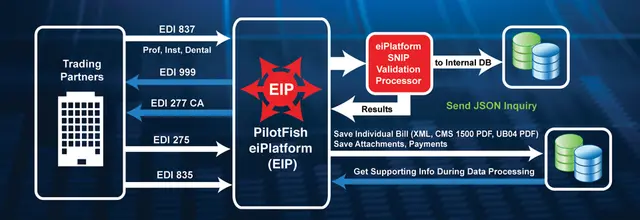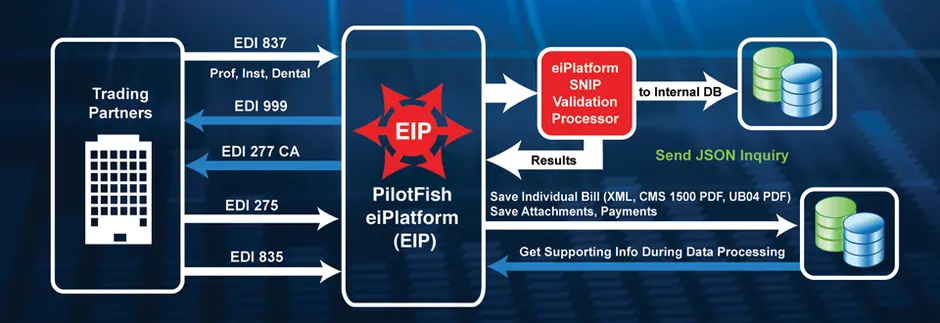EDI Workers’ Comp Claims Payment Modernized End-to-End in Under a Year!
Industry-wide, payers recognize the need to modernize technology infrastructure to improve profit margins. This leading workers’ comp insurance carrier for business embarked on a large-scale effort to modernize its workers’ comp claims management system. Critically unsupported and dated legacy EDI solutions demanded the replacement of workers’ comp claims integration end-to-end with robust EDI functionality on an accelerated schedule. The firm partnered with PilotFish Integration Solutions for industry-leading EDI technology and deep EDI expertise in this critical project.
THE CLIENT
The client, a leading workers’ comp insurance provider, processes over half a million claims per week. To expedite settlements and improve profitability, they were determined to accelerate their digital journey. The top priority was modernizing and automating their end-to-end claims management system, which included replacing the current sunsetted EDI integration system.
The replacement system had to be best-of-breed, supporting advanced SNIP validation of types 1-7, with superior accuracy, efficiency and scalability to streamline and customize the validation process. Moreover, the solution needed to offer real-time operational insights into transaction processing, including dynamic reporting with data visualization.
THE CHALLENGE
The company challenged its IT leadership to demonstrate the best and fastest payback on its investment in modernizing claims and billing processes. The search was for a single integration solution to improve the claims handling process by driving productivity and informing decisions that contribute to the swift, cost-effective closure of workers’ comp claims.
The new platform had to deliver industry-leading claims integration experience and deep expertise in the insurance industry. The pressing challenge was the replacement of both dated and unsupported legacy integration solutions. The company had a one-year can’t-miss deadline for replacement with an advanced fully integrated platform with all the functionality needed for end-to-end claims adjusting.
Advanced, robust X12 EDI integration capabilities were a foremost requirement, as many workers’ comp claims carry a medical expense reimbursement as part of the coverage. This includes the ability to accept and transform EDI transactions for electronic billing and all the related HIPAA transaction sets.
After an extensive review of leading integration solutions, the selection was narrowed down to PilotFish competing head-to-head with a single competitor. PilotFish’s superior EDI expertise and unmatched built-in EDI functionality won the engagement and confidence that the critical deadline would be met.
THE SOLUTION
The PilotFish suite of integration products enables the integration of anything to anything anywhere –regardless of operating systems, databases, data formats, communications protocols and security programs.
The clients processed over half a million worker’s comp claims transactions on a weekly basis, both batch and real-time, that flowed in from an array of clearinghouses and other sources. Processing EDI 837, 835, 275, 270/271 and 276/277 transactions accurately within complex workflows presented huge hurdles. Batch transactions were received in Amazon S3 buckets, while real-time transactions arrived as embedded EDI data in a SOAP XML message. Since PilotFish is data, environment and process agnostic, none of these factors presented major impediments to moving forward fast.

EDI Batch Workflow with PilotFish Platform

EDI Real-time Workflow with PilotFish Platform
Designed for ease-of-use and high efficiency, PilotFish’s unique graphical point-click-drag-and-drop Automated Assembly Line approach and visual Data Mapper configure all integrations using the same consistent methodology. Each stage of the Automated Assembly Line has a drop-down list of configurable options. Users simply selected the source of the data, connectivity to the source, routing, as well as the connectivity and data format consumable by the target. All incoming data is automatically transformed into an XML representation so that a single open-source W3C language, XSLT, can be used to transform the data.
In transforming its workers’ comp claims systems, the client relied on PilotFish’s built-in components for X12 EDI and PilotFish’s comprehensive knowledge of X12 schemas and standards. They quickly confirmed in a tough environment that PilotFish delivered the most comprehensive and innovative support of any product on the market for EDI and SNIP Levels 1-7.
With PilotFish, SNIP Levels 1-7 are validated via its stand-alone rules-driven EDI SNIP Validation Processor. Rules generated from X12 documentation operate within the Validation Processor, a highly scalable and customizable multi-threaded framework for executing validation rules and external code set testing. The process identified and/or fixed errors, incorrect values and incorrect usages. Unknown segments and data were captured for subsequent conversion and manipulation to facilitate multiple tries.
Validations ensured that the files met the structural standards laid out by X12 and beyond by validating specifics, such as if sets of codes are updated on a regular basis or what fields also must be present. Necessary or missing data could be automatically inserted. Adding SNIP Level 5 supported easier generation of EDI 277 Claims Acknowledgement after EDI 837 Claims were received. PilotFish’s innovative EDI integration enabled customized rules for SNIP 6 and 7 services and customer-specific rules, making meeting requirements and requests from stakeholders and external partners easier.
PilotFish EDI validation and XML transformation immediately provided standardized and structured formats for internal and external downstream processing and far greater interoperability.
In short order, workers’ comp claims processing achieved a huge advantage with PilotFish’s X12 Validation Processor and the parallel processing of thousands of validation rules at record speeds.
Support for non-EDI formats presented no problem, as PilotFish’s any-to-any data transformation capabilities and protocols supported all file-based integration scenarios.
Meeting critical benchmarks, the team was well on the way to replacing the current systems with PilotFish integration engine’s built-in capabilities for incoming data validation and translation, outgoing transaction construction, acknowledgment generation, process orchestration and scheduling.
While the challenges were large, the collaborative effort between the focused client IT team and PilotFish exploited the advantages of being a small team with direct communication lines. As soon as a problem arose, the partnership came up with a solution and moved forward. Mutual respect and no finger-pointing ruled, especially as it came down to the deadline to pull the switch. Successful system replacement in record time realizing and demonstrating cost and time savings wowed management at all levels.
THE BENEFITS
As the client’s team experienced and realized more and more what PilotFish could do and solve, they secured IT management approval to collaborate with PilotFish’s solution architects to solve problems or create solutions leveraging PilotFish’s full product offering.
Again and again, PilotFish understood a need or problem, dissected it and brought to bear core competencies needed to succeed and move on.
For example, utilizing the PilotFish framework of XML, highly useful dynamic PDFs were generated for underwriters and adjusters that filtered out only relevant data for decisions. PilotFish’s customizing process turned raw data into a PDF visually useful for the people managing the claims behind the scenes.
Here, leveraging sophisticated architecture and built-in PilotFish capabilities quickly improved workers’ comp claims handling and informed decisions that contributed to the swift, cost-effective closure of claims.
In modernizing, the client leveraged PilotFish’s Docker support to push and pull Docker images at will for new builds via Amazon S3.
On the operational front, management was blown away by the advantages realized with the PilotFish eiDashboard that allowed capturing new significant amounts of data coming through on transactions and to report on them in a variety of different ways that supported the demanding needs of the day-to-day operational support for critical workflows. The eiDashboard’s ease-of-use allowed tracking of key attributes and what was happening in real-time utilizing drop-downs, custom search and filtering functionalities. Custom reports could now be generated with alacrity in order to see important data in more useful ways and take action.
Resources of all types at PilotFish proved to be scaled up and down easily. The PilotFish architecture proved flexible, scalable and infinitely extensible in action. Financially, On-Demand Licensing was advantageous for the client’s mix of batch and real-time processing from a cost perspective as it is usage-based.
In assessing the benefits and cost-effectiveness of PilotFish’s Integration Solution and engagement, the client emphasized that a huge part of what made the successful replacement of its workers’ comp integration solution possible in less than a year was precisely PilotFish’s ability to assemble a team of the right people to put the right effort towards the right problem. Simply put, PilotFish had the architecture, the technology and the people critical to success in its role as a strategic partner.
Since 2001, PilotFish’s sophisticated architecture and innovations have radically simplified how healthcare integration gets done. Today PilotFish offers the most flexibility and broadest support for healthcare integration of any product on the market and is system, platform and database agnostic. PilotFish’s healthcare integration suite includes support for all healthcare data formats (HL7 2.x, HL7 3.x, FHIR, CCD/CCDA, JSON, XML, X12 EDI, NCPDP, etc.) and communication protocols.
PilotFish is architected to be infinitely extensible with our Open API and flexible to meet any integration requirement. PilotFish distributes Product Licenses and delivers services directly to end users, solution providers and Value-Added Resellers. To learn more, visit our Case Studies or specific solutions like HL7 Integration or X12 EDI Integration.
PilotFish Healthcare Integration will reduce your upfront investment, deliver more value and generate a higher ROI. Give us a call at 813 864 8662 or click the button.
X12, chartered by the American National Standards Institute for more than 35 years, develops and maintains EDI standards and XML schemas.


